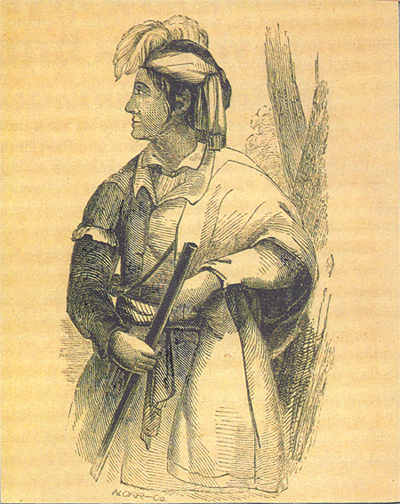The whites…dealt unjustly by me. I came to them, they deceived me; the land I was upon I loved, my body is made of its sands; the Great Spirit gave me legs to walk over it; hands to aid myself; eyes to see its ponds, rivers forests, and game; then a head with which I think. The sun, which is warm and bright as my feelings are now, shines to warm us and bring forth our crops, and the moon brings back the spirits of our warriors, our fathers, wives, and children. The white man comes; he grows pale and sick, why cannot we live here in peace? I have said I am the enemy to the white man. I could live in peace with him, but they steal our cattle and horses, cheat us, and take our lands. The white men are as thick as the leaves in the hammock ; they come upon us thicker every year. They may shoot us, drive our women and children night and day; they may chain our hands and feet, but the red man’s heart will always be free.
History of the Second Seminole War, 1835-1842 by John K. Mahon is the source for the above quote by the brave Seminole warrior, Coacoochee. Mahon’s work is one of the few books to illuminate an oft forgotten about American War, one that had lasting implications and a dramatic story. The Seminole War involved a colorful cast of characters, extremely harsh environs, treachery and bravery, and a war of insurgency that teaches us lessons to this day. The Seminole Wars are but just one chapter in the long story of the Indian Wars and John K. Mahon gives a very clear and concise account of those wars of Florida.
Mahon structures the book chronologically, starting with the background of the First Seminole War and the series of treaties that followed it. Even from the beginning, coexisting with the Seminoles was not in the plans of the settlers of Florida, nor strongly supported by the U.S. government. Horribly debilitating treaties essentially took the land out of the Seminoles hands for nothing. The plan was to move them west of the Mississippi along with the Indians of Georgia. Skirmishes continued throughout the years of 1818-1835, as many Seminoles refused to yield. Finally, under the Presidency of Andrew Jackson, General Winfield Scott was given command in 1836 which marks the beginning of the Second Seminole War. Mahon then takes us through the rest of the war in chapters split up by the six commanding officers, describing events under each officer’s command.
Most attribute the Indian Wars as a natural consequence of Manifest Destiny and in the case of Florida and the Seminoles, it played a part. However, the most important factor may have very well been the slavery issue. Southern states were infuriated by the fact that slaves would escape to Florida and find sanctuary with the Indians. Reclamation of property was a leading reason why the Department of War and the state militias felt compelled to remove the Seminoles from Florida. How to treat the Black Seminoles became one of the most divisive issues to every commanding officer in Florida. Along those lines, the commanding officers also recognized that the “crackers” were also to blame for much of the violence between themselves and the Indians, and that too represented a major problem for the officers. Had it not been for the runaway slave issue, Florida may have been ignored for quite some time.
Anyone that has lived in Florida or spent a fair amount of time in Florida can attest to the brutal environment of Florida in the summer, even now with the advent of AC. War in the unforgiving swamps of Florida tested the hardiest of soldiers and often broke them. Disease, humidity, sawgrass, never ending rain and moisture, snakes, and alligators all posed just as much as threat to the Army as the Seminoles. In fact, disease killed many more soldiers than the Seminoles. A telling anecdote is that Colonel John F. Lane, deranged by fever and fatigue, ran his sword through his right eye. The fact that most soldiers considered Florida the poorest land ever fought over exemplifies the runaway slave factor. The conditions were brutal and the pay miserable, yet many future officers of the US Army gained considerable experience in Florida and would use that knowledge in future Indian Wars and the Civil War.
History of the Second Seminole War, 1835-1842 is a dense history and definitely does not fit under the breezy category. At times it can as trudging of a read as the Seminole War was a long, brutal trudge for both sides. However, Mahon provides an endlessly fascinating account of the Seminole War and the politics of the Seminole War. History of the Second Seminole War, 1835-1842
is a must read for anyone interested in Florida history and/or in general US history during the mid 19th century.
